On the Navajo Nation, the List of Mystery Wells Continues to Grow
Old oil wells on the reservation spew chemical-laden water. The feds have done little to honor treaty obligations to clean them up.
By Jerry Redfern, Capital & Main
This story was originally published at Capital & Main, a NMPBS partner.
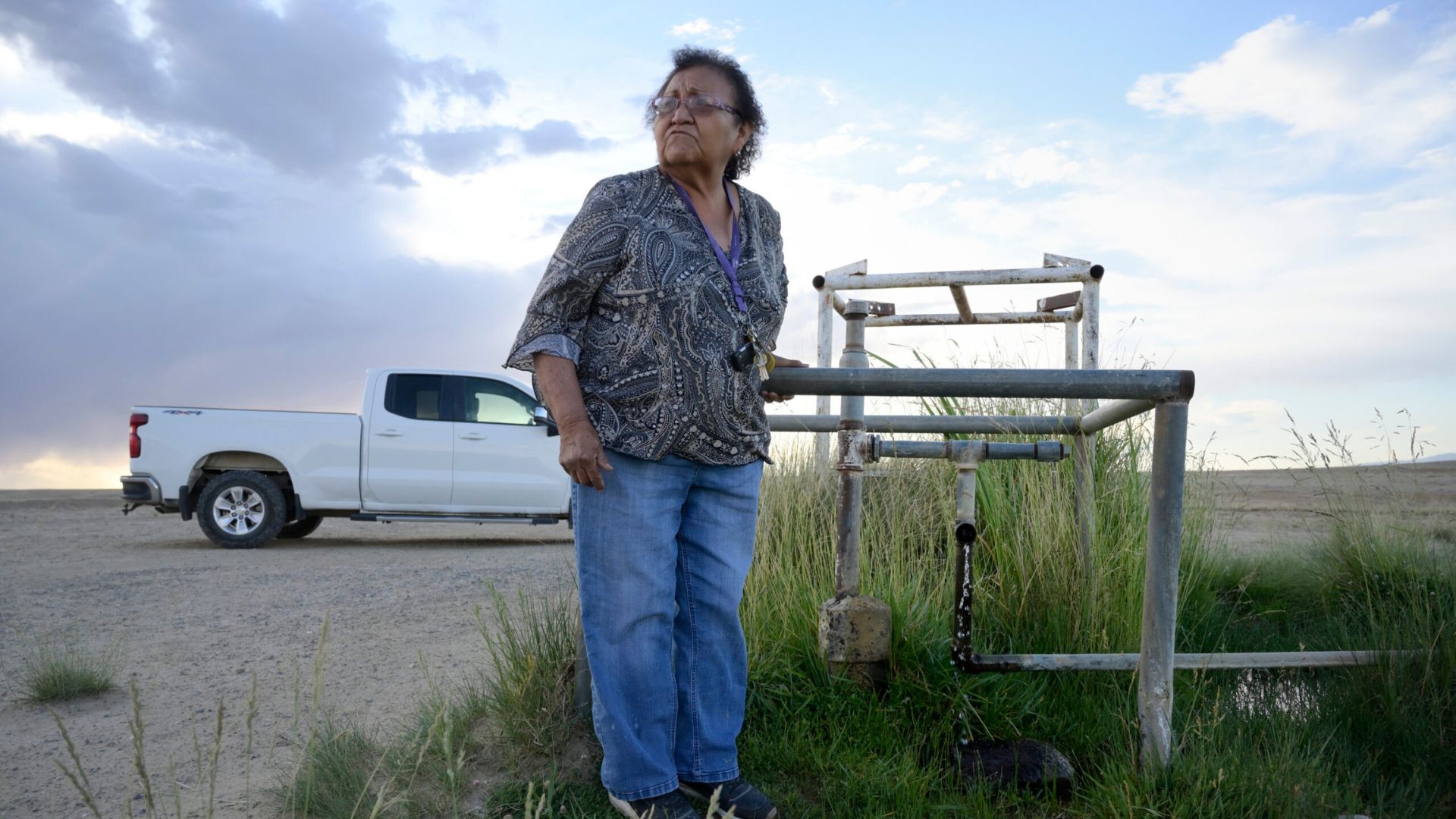
On a warm evening in early June, Loretta Johnson pointed her white Chevy Silverado with a Navajo blanket-patterned steering wheel cover south on the main road leading out of Shiprock, New Mexico, and hit the accelerator — lightly.
The retired nurse drove herself and a friend on the plumb-straight road and weaved stories as mile-wide dust storms tumbled across a landscape that inspired the Road Runner cartoons. And as the stories picked up in her rolling cadence, the speedometer ticked down. She was on a mission and she tackled it at her own pace, so the occasional driver on the road pulled around and passed her with no honking or lights flashing.
Johnson and her friend (who did not want to be identified over concerns for his job) are Diné, as the Navajo people call themselves. She grew up in a small house in a small valley near a small town several miles from where she’s driving on the nation’s biggest Native American reservation.
On the treeless horizon to the west stands the iconic stone peak Shiprock, and ahead is a water well that played a pivotal role in her life. Not so many years ago, before poor health kept her husband at home, Johnson and he would come to this well to fill a pair of 55-gallon barrels with water they would haul to their cattle in Red Valley, 30 miles away.
“Someone told me it was saltwater. But the cows, they drank it,” she said as she pulled up to the site. What she didn’t know then has since become clear.
An unmarked fence surrounds the spot, and truck traffic has turned the entry into a muddy bog. The well’s history is murky; it was drilled decades ago, and has few existing records. The wellhead itself is a six-inch pipe a little over four feet tall and crusted in rust and white deposits. A takeoff line runs along the ground to a nearby elevated tank where people still drive in to fill up.
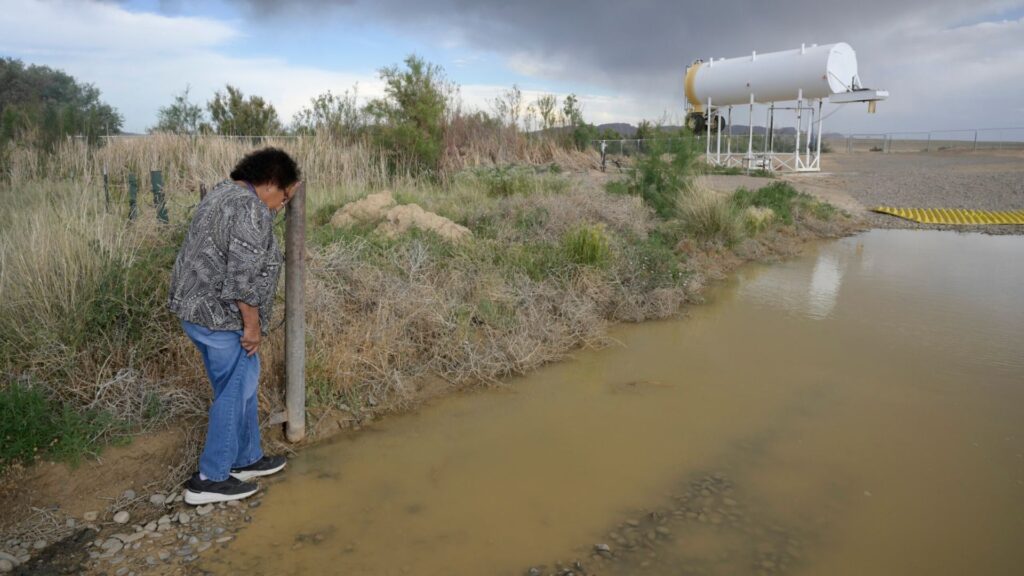
It’s not the only well like this. Dozens of old, unplugged wells speckle the rangeland in this corner of the Navajo Nation. And it’s not always clear what their original purpose was. Today, some are just rusty pipes in the ground. But some smell like gasoline. Some occasionally burp oil. And several produce copious amounts of water in a parched region.
Oil and gas drilling here goes back more than a century, and the further back you go, the fewer records exist of what was drilled where or for what purpose. An unknown number of today’s flowing water wells come from that industrial legacy. “If somebody’s drilling for oil, they’re going to hit water bodies along the way,” said Steve Austin, a senior hydrologist with the Water Quality Program in the Navajo Nation Environmental Protection Agency’s Shiprock office. And that can lead to contaminated water wells.
Johnson never drank the water from this particular well herself, and she wouldn’t let her dogs drink it, either — which was probably for the best. A water quality test seven years earlier determined it is laced with sulfates and benzene — a common component of crude oil and a known carcinogen — at rates that exceed federal and tribal standards for human consumption and could make livestock sick as well.
When her friend tells her that this well where she used to water her cattle — like many on the Navajo Nation did — is an old, contaminated well, possibly from the oil industry, Johnson pauses before saying, “I didn’t know what was in those waters.”
* * *
The federal Environmental Protection Agency knew.
In 2018, scientists from the agency tested 46 old wells on the Navajo Nation that run in an arc from Shiprock northwest into Utah. The agency published a report in 2019 documenting what they found: a lot of polluted water.
The study looked for dozens of chemicals including lead, arsenic, sulfate, benzene, uranium and chloride, as well as total dissolved solids — a measure of minerals in suspension. “That’s one of the good things about this study,” said Austin, the hydrologist with the Navajo Nation EPA. “It showed us whether or not they were a problem.” Many were. Of the wells they tested, 18 had some sort of pollution that exceeded drinking water standards, sometimes dramatically.
For example, in the well where Johnson drew water for her cattle, labeled NM-013 in the study, the EPA recorded benzene levels at 7.9 parts per billion, 58% higher than the 5 parts per billion maximum allowed for human consumption under the EPA’s own standards.
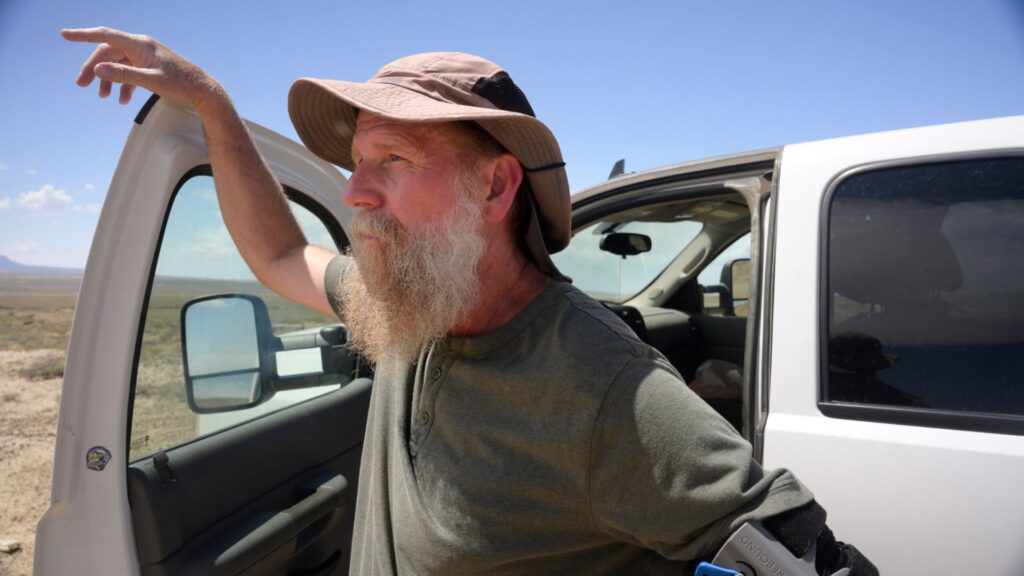
Many find even those standards too lax. The European Union‘s drinking water limit for benzene of one part per billion is one-fifth the EPA level, meaning the levels in NM-013 exceed European standards by 690%.
The Environmental Working Group, an environmental research and advocacy organization, tracks benzene levels and other pollutants in water systems across the country and recommends even stricter standards than those used by the EPA or the European Union: 0.15 parts per billion, or 1/33rd the EPA level.
“If you’re thinking about this in terms of human consumption … In drinking water, you want the level to be zero,” said Tasha Stoiber, senior scientist at the Environmental Working Group.
Of other, more polluted wells on the EPA list, she said, “You don’t even want to touch that water.”
Looking through the tables of contaminants in the list, she said, “Obviously, there’s arsenic issues, there’s hydrocarbon issues — benzene, oil and gas contaminants.” And most of the water on the list: “It’s not fit for human consumption.”
But NM-013 is still open for business. Stoiber said that beyond the benzene pollution, the level of total dissolved solids in the well was enough to make people and livestock acutely sick. “It’s also going to taste really, really bad,” she said.
On the Navajo Nation, many rely on open wells — flowing or pumped — to raise small livestock herds, as Johnson did. Water has always been precious in this arid corner of the country, and it has grown even more scarce. The past winter’s woeful snowpack and negligible spring runoff led tribal President Buu Nygren to declare a drought emergency at the beginning of June. According to the announcement, more than 7,500 stock ponds and 900 wind-powered wells had lost “capacity and functionality” across the Nation. That leaves people with fewer choices among the remaining water wells.
At the Navajo Nation EPA, Austin monitors and regulates everything from septic systems to mine sites to wastewater spills — anything that affects the Navajo Nation’s water quality. (The Navajo Nation EPA operates independently of the federal body with the same name, but uses the same water standards.)
As soon as any water flows on the surface, “It is a water of the Navajo Nation,” Austin said, and it falls under his office’s jurisdiction. Same for anything that pollutes those waters. Oil and gas production aren’t directly in his wheelhouse, but, “I come into play if there is a spill or some kind of mess,” he said. Over the past 15 years, he has added finding and mapping mystery wells to his duties.
All together, the Navajo Nation Water Quality Program has a staff of six to cover an area a little bigger than West Virginia. “We have a lot less water than West Virginia,” Austin said. “So there’s a tradeoff there.” He is the lead water watcher for most of the eastern half of the reservation.
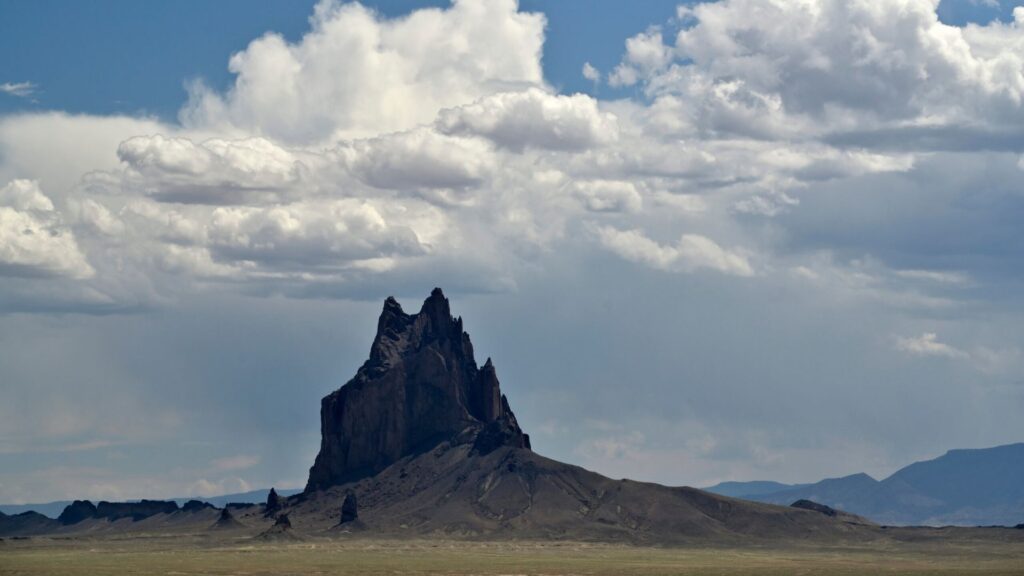
He began working with the tribe in 1998, and, from the beginning, the small staff and modest funding have kept him bouncing from project to project. But he said the flowing wells have been on his mind since he started.
Back then, the Bureau of Land Management plugged extremely salty flowing wells that drained into the San Juan River, harming its quality. That program eventually ran out of money and ended.
In 2010, Austin started tallying the small water wells as they popped up in his work across the eastern reaches of the Nation. The area overlapped with a large portion of the neighboring San Juan Basin and Paradox Basin oil and gas fields. It’s not a coincidence.
If an oil company drills a well that doesn’t produce oil (or not enough to make a profit), it often plugs the well, filling the steel-lined hole with cement and sticking a metal pole in the spot to warn of the underground risks. But, sometimes, companies only partially plug a well, leaving it open to a shallow, water-bearing layer so that water can be accessed. That’s what happened repeatedly on the Navajo Nation in years past. Most had some kind of valve to control the flow, “But over time the equipment that was there either got broken or rusted out, and so now they’re just free flowing,” Austin said. Some trickle and some gush, creating everything from small bogs to small creeks.
That places the water in Austin’s jurisdiction, in part because “We assume everything is going to be drunk by a cow or a sheep,” he said.
But what’s good enough for cattle or sheep often isn’t good enough for people. Sometimes it’s not good enough for cattle or sheep, either.
“It’s untreated water. At the minimum, you’ve got to be concerned about bacteria,” Austin said. Some wells have high levels of arsenic, benzene and sulfates. And some flowing wells are also a nuisance, with undrinkable water washing out roads and hampering travel.
Several years ago, New Mexico asked the Navajo Nation to clean up a nuisance well that flowed from tribal lands onto state and private lands, turning the access road for a remote tourist spot to briny mud. Austin said he told the state, “We’ve tried. We don’t have the money.” Then the state asked the federal EPA to do it, but the feds called Austin instead, and he told them the same thing. He also told them the problem was not unique — he’d found many such wells over the years. “And they’re like, ‘What are you talking about?’ I was like, ‘Yeah, we have flowing wells all over the place.’ They’re like, ‘What?’”
Austin shared his list of 49 flowing wells he’d found across the Navajo Nation over the years in New Mexico and Utah. And in 2018, the federal EPA tested 46 of them, leading to the 2019 report.
“We do what we can,” Austin said of his office and the Navajo Nation EPA. “But ultimately the federal government still has that trust obligation to take care of it.”
According to the Department of Interior, that obligation is a “fiduciary obligation on the part of the United States to protect tribal treaty rights, lands, assets, and resources, as well as a duty to carry out the mandates of federal law with respect to American Indian and Alaska Native tribes and villages.”
The Feds certainly haven’t taken care of it quickly. In the seven years since the initial testing, no wells have been plugged — but that may soon change. The Navajo Nation cobbled together settlement money from the Gold King Mine spill of 2015 and from the Water Infrastructure Improvement for the Nation Act to plug three wells: two in Utah that spill arsenic-laden water into the San Juan River, and the original nuisance well that still washes out the road near a tourist spot. As for the other 40-some wells, they’re still flowing.
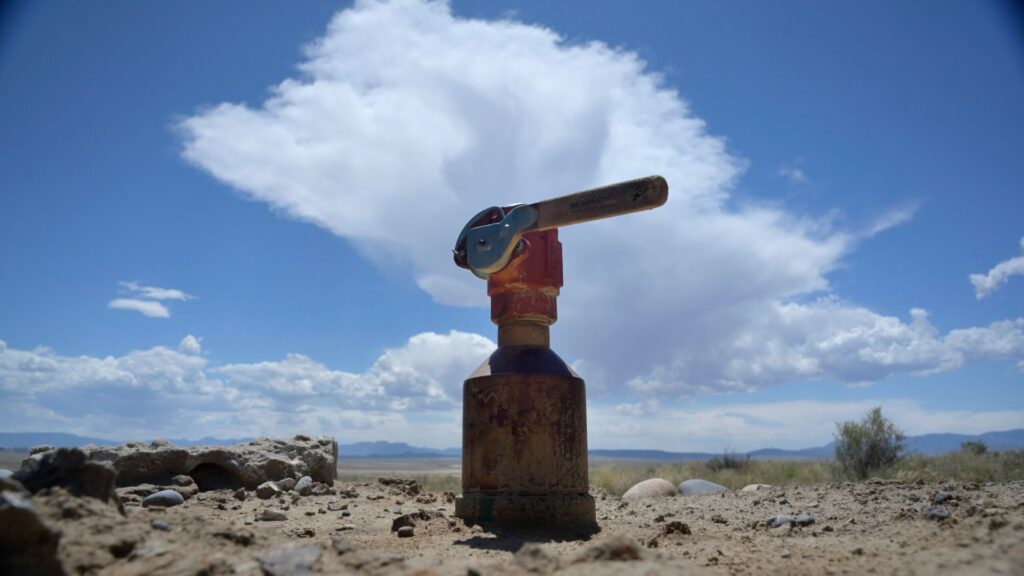
In a case of the left hand not knowing what the right hand was doing, Austin says that in 2020 the BLM and EPA asked his office if it had any oil wells that needed to be plugged. “We gave those lists to BLM and U.S. EPA and didn’t hear anything back from them,” he said.
And since the original 2018 survey by the federal EPA, Austin has found another 12 mystery wells.
When asked about the federal government’s trust responsibility to the Navajo Nation regarding these wells, Mikayla Rumph, an EPA spokesperson, said the agency “consulted with multiple tribal, federal and state agencies to gather historical information and develop a sampling plan for all of the wells. After the results came in, EPA conducted extensive local outreach.”
Eleanor Smith, Diné, said, “This [EPA] report specifically, this is the first time I’m seeing it, first time I’m hearing of it.” She has lived much of her life in chapters (the most local form of Navajo government) with some of these wells. She works with Tó Nizhóní Ání, or Sacred Water Speaks, a Navajo environmental group active in the region.
“It should be posted next to these wells. It should have been posted in the chapter houses. It should have been put on the agenda at the chapter meeting to educate the public,” she said. “Our leaders, they should have been at the forefront to say, ‘Hey, there’s this study and it’s saying that the wells … are contaminated.’”
(Austin said that signs were posted in chapter houses near the most polluted wells.)
Nicole Horseherder, the executive director and a founding member of Tó Nizhóní Ání, said the Navajo Nation government “has to go after the [federal] EPA and say, ‘Look, you allowed this. You need to fork over some money so we can hire consultants and get this cleaned up properly.’”
A Bureau of Land Management spokesperson said that questions directed to BLM were answered in the EPA response. The Bureau of Indian Affairs did not respond to Capital & Main’s questions.
* * *
It’s early June, and Austin takes a 30-minute drive from his office to the Rattlesnake Oil Field, making a tour of wells he has found over the years. The sky arcs overhead, deep blue as vast thunderheads rim the horizon. Stopping to open and close a cattle gate, he says he’s stayed with the Navajo Nation’s EPA for all these years because they treat him well. “This is another reason,” he said, nodding toward the great volcanic crag of Shiprock. “It’s beautiful out here.”
After cautiously navigating his pickup over notional dirt roads, he arrives at Rattlesnake 17: four tapered concrete and steel pillars surrounding a pipe splashing sulfur-scented water. The water looks clear, but the ground is stained orange. Another hint that the water is not fit for drinking: The well sits on cattle range, and there are no hoofprints around. But the well does have a postcard view of Shiprock in the distance.
Austin calls Rattlesnake 17 a nuisance well. The nearest homeowners, about a mile away, told him they don’t mind if it’s plugged. A century ago, Rattlesnake 17 was an oil well in the middle of the Rattlesnake community, a company town built for those working on the 200-some oil wells in the surrounding oilfield, one of New Mexico’s first.
Bricks and bolts and other rusted bits and bobs lie scattered in all directions. The ground is white rock scraped clean of topsoil a hundred years ago for some kind of building. When the oil stopped and the people left, the land was not cleaned up. Austin said, “It’s like an archaeology site.”
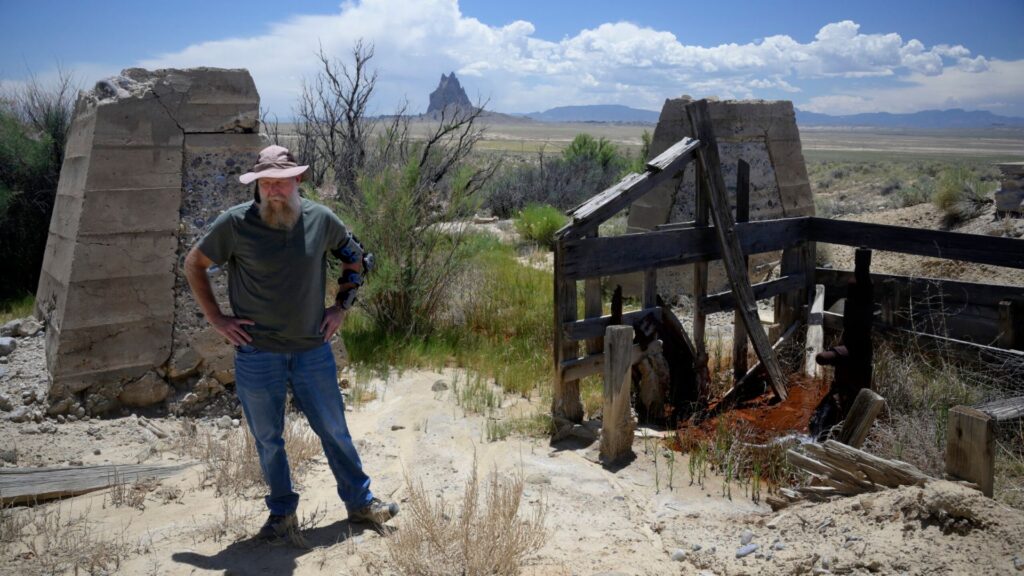
Austin first found Rattlesnake 17 in early 2018. When looking for old wells, he follows a simple process: Scan Google Earth images for one of two things — either unexpected green oases in the broad tan landscape, or the white rock of barren ground like that near Rattlesnake 17. Then check it out.
He has tried comparing what he finds with various New Mexico well databases, old maps and court records, but wells often aren’t where they’re recorded being, if there’s any record at all. “It’s really confusing,” he said. And there’s no telling what’s in the wells he finds, if anything. His first test of any new find is simple. “There’s a hole. Drop a rock. There’s a splash!” he said.
About 100 yards away from Rattlesnake 17, the next well clearly wasn’t plugged. He looks around for a rock, bends over and drops it in the open pipe. Four seconds later it booms in some kind of tank at the bottom.
Another 50 yards: a dirt hole, maybe a foot across. He drops a rock and, after a second, it hits something with a “plop.” Maybe water? Maybe something else? He doesn’t have the money to sample every well. “Nobody has enough funding to sample every water body that’s out there,” he said.
Another 50 yards: a rusty pipe with a closed valve on top, surrounded several feet in all directions by the remnants of an oil spill that’s turned into an inches-thick scab of black-brown tar. There is no marker, and Austin says there are no records for a well in this spot — it’s a true orphan well.
“It’s not a big leak, but clearly it’s got issues,” Austin said. “And who knows what it’s doing in the water formations?”
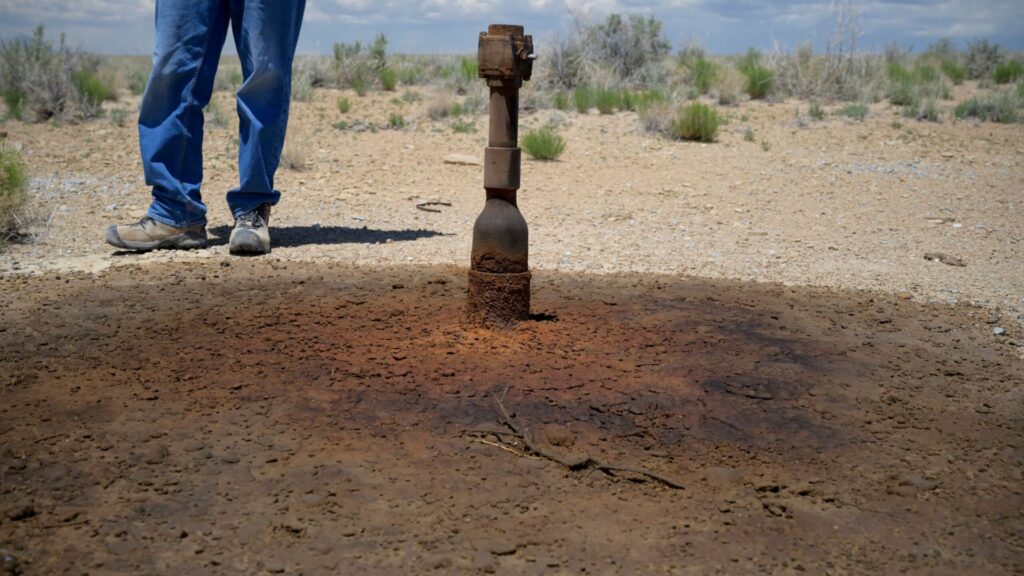
Most of the wells in the Rattlesnake field were plugged at some point. Five-foot rust-brown poles pierce the surrounding landscape marking plugged wells below — those are known factors. But what of the old, unplugged wells: Who drilled them? What were they for? Are they leaking underground? What are they leaking?
It’s not known exactly how many wells were drilled over the years. It’s not known exactly how many were properly plugged when they finally played out. It’s not known how many of those plugs may have failed over the decades.
“It’s hard to know how bad the problem is,” Austin said. “Is it an emergency situation? No. Should someone deal with it? Yes.”
* * *
Loretta Johnson still thinks of her cattle. She and her husband had 16 when they had to sell them a few years ago. When he got sick, she couldn’t tend them alone. “It’s kind of sad when you drop them off” at the auction yard, she said. “Some of them had cute names like Looney Tunes.
“Good thing we didn’t eat any of those cows,” Johnson said, thinking of hidden dangers in their flesh. Contaminated water isn’t the first hidden health threat that colors how many of the Navajo Nation view the world.
“It’s just like the uranium,” Johnson said.
From the 1940s to the 1980s, working on federal contracts, companies dug up nearly 30 million tons of uranium ore from more than 500 mines on the reservation. Families often lived close to the mines where they worked and were generally poorly notified or uninformed of the danger. The health effects continue today.
Johnson’s life has spanned most of the Nation’s decades-long history with uranium mining and its aftermath — sick people and contaminated land. She says when she was a young girl, her father built the foundation of their rural house and an outbuilding with yellow rock — uranium ore from a nearby mine where he worked. She says that one day men wearing protective clothing came and tore the house down and buried the rock, and her family moved to Shiprock town.
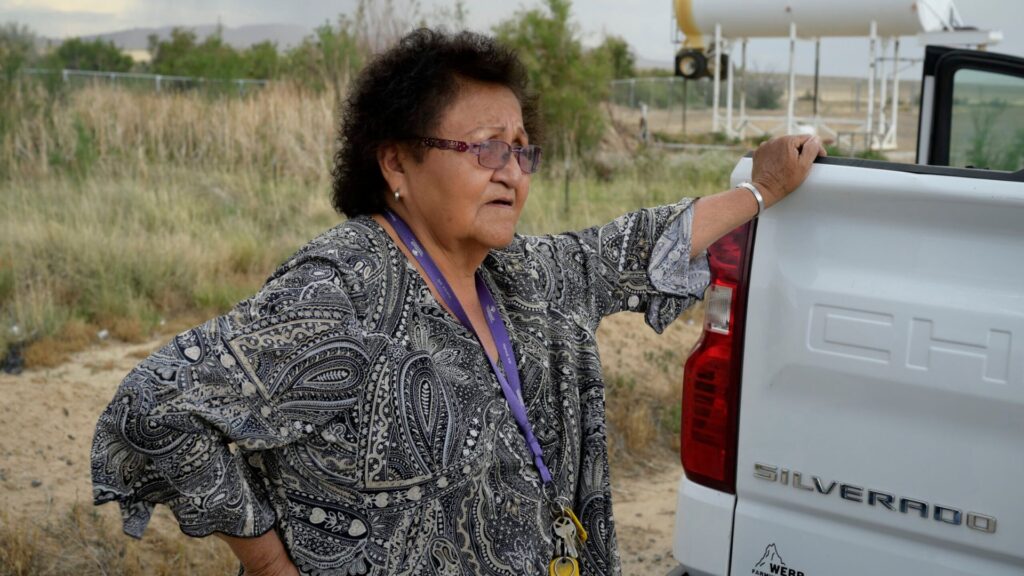
“That was not good for our health and our people didn’t know,” she said. She knows a couple of women her age who lived near the mines and died of cancer — a common local story, and one that gets her thinking about what she recently learned.
She said, “They say [the water’s] not safe, it’s contaminated,” but people watered their animals at the wells and “you don’t know which persons butchered their cows or sheep or goats to eat.” She remembers a family that owned a trading post and traded for sheep and goats; they all got stomach cancer in their 30s, she says.
“That was weird,” Johnson added.
Meanwhile, the nature of traditional ranching combined with the ongoing drought puts more pressure on the remaining wells — including polluted wells. “If they’re contaminated, they really should be shut down,” Smith, with Tó Nizhóní Ání, said. “But I know a lot of times, even in uranium areas, people are so desperate for water that they’ll even drink the contaminated uranium water. So it’s not a good situation.”
“One of the big problems with the Navajo Nation is that they do not understand that no one is looking out for them,” said Horseherder of Tó Nizhóní Ání. “Not the government, not the Department of Interior, not the State of Arizona [where the majority of the Navajo Nation sits] and not the company” that drilled the well.
Over the years, her group has fought to protect tribal water rights while fighting against coal mining and other fossil fuel developments on the nation.
“If we don’t get a handle on this, we’re going to be living in a toxic dump site,” Horseherder said. “I truly think that it’s intentional. It’s intentional towards Indigenous people.”
This story was originally published at Capital & Main, a NMPBS partner. Copyright 2025 Capital & Main.

